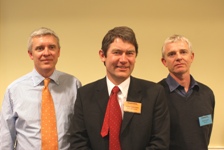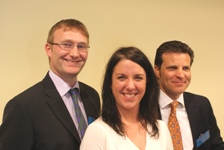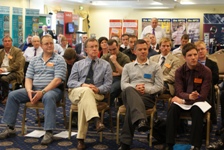Returning after a break of one year, delegates gathered for two days of high-class topical presentations at the Pest-Ventures seminars held at the Yew Lodge hotel near Nottingham on
20 and 21 April.

As ever, the programme addressed issues currently being faced by the pest control industry. But one problem the organisers had to grabble with was the loss of two speakers and some delegates, the furthest coming from no less than Australia, due to the air chaos caused by all that Icelandic volcanic ash.
On day one, rodenticide resistance featured extensively. Pest controllers may think of this as a new problem, but Dr Alan Buckle of Reading University was quick to point out that anticoagulant resistance in the Norway rat was first discovered in Scotland in 1958. Traditionally tests for resistance simply involved feeding the caged animal on field strength rodenticides for an arbitrary period (normally four to six days). But as Dr Colin Prescott also of Reading University explained: “Intuitively, survival of such a test provided evidence of resistance that would have a practical effect in the field, although results were dependant on consistent feeding in a caged environment, and for Norway rats this is often not the case.” In addition, these tests were long-winded and expensive.
|
However, by 2005, as a spin-off from warfarin resistance testing for humans where rats were used as the test species, researchers in Germany developed new and sophisticated DNA-sequencing technology. This identified which part of the genetic code of rats and mice carried the DNA sequence, or genes, is altered in rodents resistant to anticoagulants. These tests can now be undertaken relatively quickly and inexpensively – review how the tests are done – click here. Of great significance to the UK pest control industry, a consortium consisting of the leading UK rodenticide manufacturers has been formed with the aim of establishing the extent of resistance mutations in and around suspected hotspots using DNA from rat tails. The project is being led by Dr Dougie Clarke from Huddersfield University who also spoke at Pest-Ventures. He explained: “The study, which is about to start, will target 58 areas surrounding these hotspots and test 10 animals for resistance conferring mutations at each location.” This may not answer all the questions posed but will certainly be a scientifically-based step forward. From the Wildlife Management & Licensing team of Natural England, Paul Butt implored: “The use of pesticides play a vital part in dealing with pest infestations. It is a pest controller’s responsibility to ensure they are used correctly. If not these products run the risk of acquiring a bad reputation leading to their use being curtailed by legislation.” Paul illustrated his talk with examples which showed some of the blatant mis-use cases investigated by his team. Paul also discussed the deployment of the sometimes hotly debated burrow destruction devices used for rabbits, moles and rats. Something of a first, Pest-Ventures was pleased to welcome the Rodenator team, distributors of the Rodentator machine, to the small accompanying exhibition. Bedbugs, biological controls and birds took centre stage on the second day. Clive Boase of the Pest Management Consultancy gave an excellent talk reviewing the practical issues surrounding bedbug monitors. Richard Naylor from the University of Sheffield told delegates about the research he is conducting into bedbug harbourage and dispersal strategies, whilst David Cain of Bed-Bugs Ltd impressed upon delegates the increasing geographic spread of this pest. On a practical level, Tony Bull of the London Borough of Hounslow detailed the work undertaken by the Greater London Pest Liaison Group in creating its good practice guides. Stars of the show however were four-legged Basil and Charlie – the two bedbug detection dogs commercially used by Adam Juson of Merlin Environmental to detect this insect in hotels, cruise liners and the like – see report on how its done in Pest magazine – click here. Tempting fate, as his dogs are not used to a large audience, they were set a practical test to display their prowess in the hotel lounge area. Fortunately their quarry was found and the audience very much impressed. Equally novel means of control and detection were also debated later in the day – the use of pheromones to control insect pests from Garry Pease of Exosect and the use of magnetically charged particles to enhance insecticide delivery from YPIL-Pest Elimination. Dr John Simmons of Acheta also presented his practical findings of catch comparisons using three types of pheromone traps. From this work Dr Simmons concluded that the Demi-diamond traps are a far more sensitive monitor of insect activity than traditional funnel or delta traps Those with an interest in birds were not disappointed. Consultant Peter Rock updated delegates on the status of urban gulls in the West Country, whilst Andy Baxter from FERA brought the theme of air travel problems full-circle describing the challenges posed by birds to aircraft and airfields. Over the two days it was not all talk from the presenters. Delegates had their chance too, breaking into groups to discuss and suggest ways forward to progress the Aiming High good management practice agreement for effective relationships between pest controllers, environmental health officers and food businesses implemented by Westminster City Council.
|
|
|
|
|
||


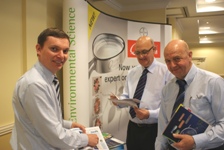
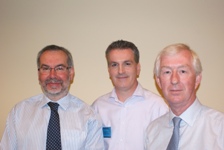
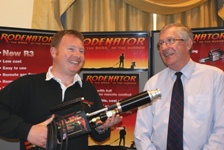
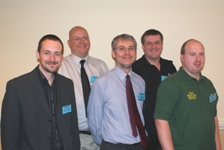
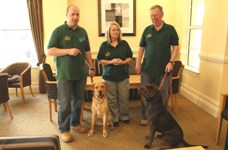 Canine detectors. Basil (left) and Charlie with the Merlin team:
Canine detectors. Basil (left) and Charlie with the Merlin team: